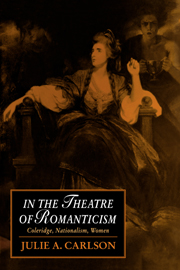Book contents
- Frontmatter
- Contents
- Acknowledgments
- List of abbreviations
- Introduction: Commanding genius in English romantic theatre
- 1 Constituting bodies politic and theatric
- 2 Coleridge's German revolution: Schiller's Wallenstein
- 3 A stage for potential men
- 4 Romantic antitheatricalism: surveilling the beauties of the stage
- Conclusion. A theatre of remorse
- Notes
- Index
4 - Romantic antitheatricalism: surveilling the beauties of the stage
Published online by Cambridge University Press: 12 September 2009
- Frontmatter
- Contents
- Acknowledgments
- List of abbreviations
- Introduction: Commanding genius in English romantic theatre
- 1 Constituting bodies politic and theatric
- 2 Coleridge's German revolution: Schiller's Wallenstein
- 3 A stage for potential men
- 4 Romantic antitheatricalism: surveilling the beauties of the stage
- Conclusion. A theatre of remorse
- Notes
- Index
Summary
Two results of the foregoing analysis of Coleridge's plays prove useful in evaluating theatre criticism by the best-known romantic writers on theatre, William Hazlitt, Leigh Hunt, and Charles Lamb. As with the content of plays in Coleridge's second stage, these men's theatre criticism evaluates acting and the proper nature of acts through categories of gender. Like the plays, it devotes special attention to the activity of female characters as part of cultural reflections on the French Revolution. But while Coleridge's plays arrive at their scrutiny on women through an interdiction on commanding geniuses like Napoleon, romantic theatre criticism departs from the fact that the most commanding performer of the day is a woman, Sarah Siddons. Both bodies of work register profound ambivalence toward the increased visibility of female actors in this age. Like Zapolya, theatre criticism capitalizes on this visibility while seeking to eliminate it from the public sphere.
The second result concerns the formal status of Zapolya as Coleridge's most theatrical because feminocentric play and the play that terminates his involvement with theatre. It foregrounds the antitheatricalism of these men's writings on theatre and its inseparability from sexual politics. This strain in the work of Hazlitt, Hunt, and Lamb comes as more of a surprise than in Coleridge's, since, unlike with him, their enthusiasm for theatre is widely acknowledged. Equally surprising, perhaps, is the suggestion that misogyny shapes their antitheatrical impulses, for their antitheatricalism is generally restricted to the idea of representing Shakespeare.
- Type
- Chapter
- Information
- In the Theatre of RomanticismColeridge, Nationalism, Women, pp. 134 - 175Publisher: Cambridge University PressPrint publication year: 1994



